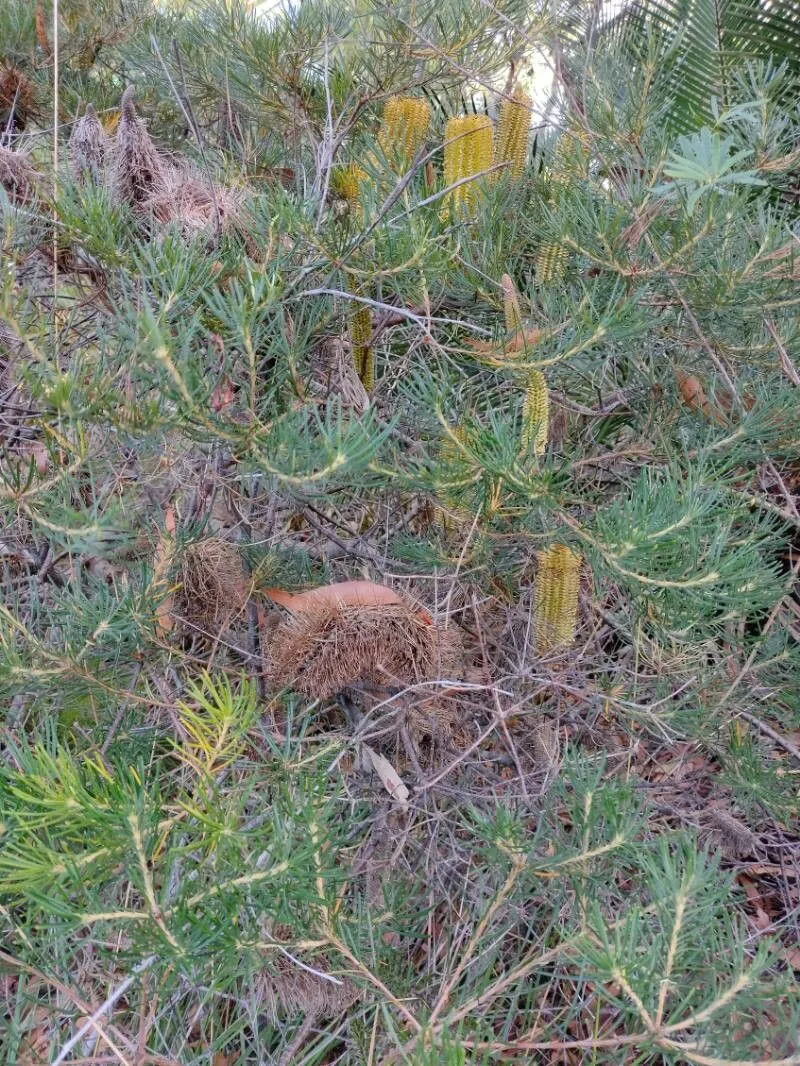
Author: Sm.
Bibliography: Spec. Bot. New Holland: 13 (1793)
Year: 1793
Status: accepted
Rank: species
Genus: Banksia
Vegetable: False
Observations: E. Australia
Hill banksia, scientifically known as Banksia spinulosa, is a remarkable plant native to Eastern Australia. First described in the late 18th century, precisely in 1793, this species has since been a subject of fascination among botanists and horticulturists.
Belonging to the Proteaceae family, Hill banksia is well-adapted to the diverse climates of Eastern Australia, showcasing an array of survival strategies. The plant typically thrives in its native habitat, which includes woodlands, coastal heaths, and rocky outcrops. Its ability to flourish in various soil types and conditions attests to its resilience and adaptability.
One of the most striking features of Banksia spinulosa is its unique inflorescence. The flower spikes, which can reach up to 30 centimeters in length, are adorned with a dense arrangement of small flowers. These blossoms exhibit a captivating color palette ranging from golden yellow to vibrant orange-red, often creating a visual spectacle against the backdrop of the Australian landscape.
The foliage of Hill banksia is equally noteworthy. The leaves are long, narrow, and serrated, providing a distinctive texture. They not only contribute to the plant’s aesthetic appeal but also play a crucial role in its survival, as they are adapted to retain moisture and withstand the often harsh Australian environment.
Banksia spinulosa is not just visually appealing but also plays a vital role in the local ecosystem. It is a key food source for various wildlife, including birds, particularly honeyeaters and small mammals, which are attracted to its nectar-rich flowers. Additionally, the plant’s seeds provide sustenance for a variety of insects and animals, thereby supporting biodiversity.
In landscaping and garden design, Hill banksia is valued for its hardiness and ornamental qualities. It can be cultivated relatively easily, provided that its basic requirements for well-drained soil and adequate sunlight are met. Gardeners and landscapers often use it as a feature plant, border plant, or even in container gardening to add a touch of native Australian flora to their spaces.
In summary, Banksia spinulosa, or Hill banksia, is an enduring symbol of Australia’s botanical diversity. Its striking flowers, robust foliage, and ecological significance make it a cherished species among both nature enthusiasts and horticulturists.
Eng: golden candlesticks, hairpin banksia, hill banksia
Swe: hårnålsbanksia
En: Hill banksia, Golden candlesticks, Hairpin banksia
Sv: Hårnålsbanksia
Taken Jul 25, 2022 by Michal Svit (cc-by-sa)
Taken Aug 28, 2022 by John Dani (cc-by-sa)
Taken Feb 12, 2022 by Cracotte13 (cc-by-sa)
Taken Apr 14, 2019 by yun yang (cc-by-sa)
Taken Apr 12, 2022 by Boris Therock (cc-by-sa)
Taken Jul 27, 2022 by Michal Svit (cc-by-sa)
Taken Apr 25, 2019 by ian connop (cc-by-sa)
Taken Aug 10, 2021 by ian connop (cc-by-sa)
Taken Apr 12, 2022 by Boris Therock (cc-by-sa)
Taken Jul 9, 2020 by thom higgins (cc-by-sa)
Taken Aug 10, 2021 by ian connop (cc-by-sa)
Taken Nov 17, 2021 by Nickisht (cc-by-sa)
Taken Apr 12, 2022 by Boris Therock (cc-by-sa)
Taken Apr 12, 2022 by Boris Therock (cc-by-sa)
Taken Mar 15, 2020 by Georg Dean (cc-by-sa)
Taken Aug 10, 2021 by ian connop (cc-by-sa)
Family: Myrtaceae Author: (F.Muell.) K.D.Hill & L.A.S.Johnson Bibliography: Telopea 6: 402 (1995) Year: 1995 Status:…
Family: Rubiaceae Author: Pierre ex A.Froehner Bibliography: Notizbl. Bot. Gart. Berlin-Dahlem 1: 237 (1897) Year:…
Family: Sapindaceae Author: Koidz. Bibliography: J. Coll. Sci. Imp. Univ. Tokyo 32(1): 38 (1911) Year:…
Family: Asteraceae Author: A.Gray Bibliography: Pacif. Railr. Rep.: 107 (1857) Year: 1857 Status: accepted Rank:…
Family: Fabaceae Author: Medik. Bibliography: Vorles. Churpfälz. Phys.-Ökon. Ges. 2: 398 (1787) Year: 1787 Status:…
Family: Aspleniaceae Author: (Cav.) Alston Bibliography: Bull. Misc. Inform. Kew 1932: 309 (1932) Year: 1932…